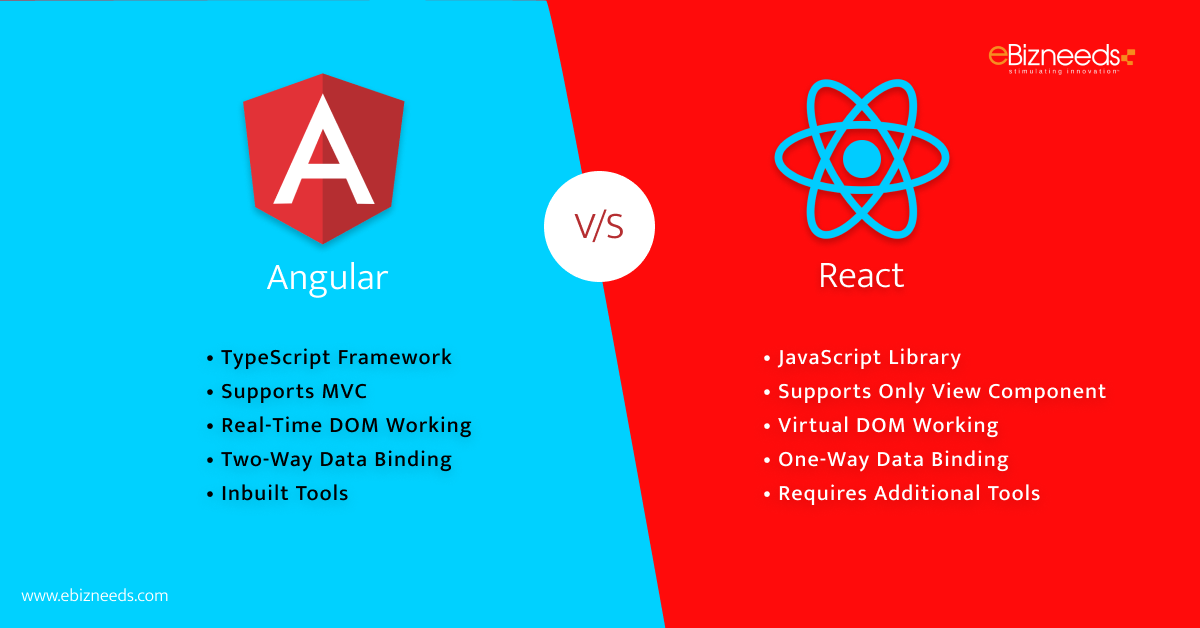Last updated on January 15th, 2024 at 01:18 pm
Choosing the right technology changes the entire shape of the project and can make a huge difference. To have a successful output, you must choose the best framework from the modern software development market. The two most popular frameworks for frontend development are Angular and React, each having its strengths and characteristics. As every organization wants to deliver a seamless and interactive UI to their customers, having the right development path becomes very important. At this stage, when you want to begin development, picking the right framework from Angular vs React is the main question. Although there are numerous unique features with each of them and they are best in their place, you can only use one. You need to understand what makes one better than another and then begin the development process. In this blog, eBizneeds will help you understand which framework will best suit your project needs.
Angular vs React – A Discussion
Angular is a front-end framework developed and maintained by Google which offers a strong structure for building applications. It has a Model View Controller (MVC) architecture that provides a complete package of features including two-way binding, TypeScript integration, and dependency injection. Angular has a good position in the enterprise market for scalable and extensive development of large-scale applications.
On the other hand, React is a JavaScript framework with libraries for building user interfaces. It was developed by Facebook and is known for its flexibility and simplicity which mainly focuses on the View aspect of the MVC pattern and the rest is addressed by external libraries. React uses virtual DOM that enhances optimal performance and makes it a preferred choice for various project types.
As both Angular and React are good for a Web Application Development Company, selecting the right tool is a must. Several factors including team expertise, community support, learning curve, and project size influence the decision-making process. To this query of Angular vs React, we will discuss features, benefits, and other necessities for making a relevant choice. This will provide a deep understanding of both frameworks and their applicability in diverse development environments.
What is Angular?
Angular is an open-source web application framework developed and maintained by Google’s Angular team. It is written in TypeScript which is a superset of JavaScript that facilitates dynamic development of Single Page Applications (SPAs). Using angular helps users with strong and modular structures for building complex applications by employing a component-based MVC architecture.
The most unique feature of Angular is two-way binding that provides seamless synchronization between the user interface and application logistics. It supports dependency injection which enhances code maintainability and helps manage dependency components. This has a set of comprehensive tools for routing, HTTP client interactions, and form handling to streamline the development process.
The versatility of Angular is proof of its compatibility with different platforms such as web, desktop, and mobile. In Angular Development, you can benefit from a rich ecosystem of libraries, tools, and an active community of developers. The Angular team regularly updates and improves the framework to align it with the best web development practices. Moreover, Angular empowers the AngularJS Development Company to create efficient, maintainable, and scalable applications across different domains.
Reasons To Use Angular In Development Projects
As we all know Angular is an open-source ecosystem that helps users create applications without effort. It has features that allow developers to create a web app under the same hood. Developers can benefit from two-way binding, templating, dependency injection, Ajax handling, RESTful API modularization, and many other features.
Considering these features will make your web app easy to use and compact. Although such features make a huge impact on the development process, here we will focus on the reasons for picking Angular as the framework of choice.
-
Reduced Coding Time
You can create apps faster without spending too much time on coding when using Angular. TypeScript, a high-level programming language, helps find errors and remove them in the initial phase of the development process of Angular which is not that efficient in other frameworks. You don’t need to worry about managing components, codes, or any service; when using Angular all these will be arranged in proper boxes.
Moreover, these boxes are called modules which makes them easy to handle. You can use these modules to create the app’s functionality while separating elements into pieces that could be reused. Overall, we can say that Angular provides cleaner coding for developers and ensures better performance and environment.
-
Google Support
Angular is developed and maintained by Google which is the main reason why people prefer this framework. Being reliable in the market and a great approach to development, angular has proven its sustainability to the industry. Also, Google is attached to Angular directly, so its ecosystem is scaling up consecutively.
Any app that comes under Google is developed using the Angular framework. This shows the reliability and efficiency of Angular and helps people gain confidence in it. As confidence rises, more and more developers are professionally using Angular in routine.
-
Offers Complete Documentation
The most helpful part about Angular is the presence of complete documentation for developers. Angular guides developers in such a manner that they can find all the required explanations in one place and you don’t have to search it anywhere else. That said, gaining knowledge from documentation is more efficient than learning a language by practicing with code.
Features of Angular
Angular is a complete and comprehensive framework that serves developers with all required features in one place. It provides a lot of features, and so we are going to discuss them below in detail.
Modular Architecture
Angular follows a model view controller architecture that allows developers to break down complex platforms into smaller and more convenient components. This modular architecture improves the organization of code and enhances collaboration between different development teams. Moreover, Angular’s components are reusable which makes it easier to store, use, and update applications over time.
2-Way Data Binding
One of the standout features of Angular is two-way data binding. This means that any changes to the user interface are immediately reflected in the application’s data model and vice versa. This bidirectional communication streamlines the development processes while reducing the need for manual DOM manipulation and resulting in more responsive and dynamic user interfaces.
Dependency Injection
Angular’s dependency injection system is a powerful mechanism that encourages the creation of loosely coupled and highly maintainable code. By injecting dependencies into components, Angular ensures that every part of the application is independent of another component. This provides easier testing because the components are tested separately with mock dependencies.
TypeScript Integration
Angular is integrated with TypeScript which serves static typing to the language. TypeScript is a superset of JavaScript, bringing numerous benefits to the development phases. Higher code maintainability, enhanced developer productivity, and better tooling support are some of the benefits for users. The static typing of TypeScript helps find errors while developing the code and reduces runtime issues while improving overall code quality.
Angular CLI
The CLI (Command Line Interface) of Angular is one of the most powerful features that simplifies the development process. It automates common tasks such as project setup, code generation, and testing. It ensures consistency in projects and helps developers focus more on developing a top-notch platform rather than dealing with configuration details.
Cross-Platform Development
Angular makes it easier to create cross-platform applications using frameworks such as Ionic and NativeScript. Because of its shared codebase, developers can create web applications with Angular and then easily extend them to mobile platforms. This speeds up the development process and lowers the release time for applications that target multiple platforms.
Robust Community and Ecosystem
As Angular is driven by the community, developers have access to a vast ecosystem of tools and solutions. This makes it easier to address challenges and find best practices or various scenarios. The community of Angular developers is active and offers a wealth of resources, third-party libraries, and tutorials, so hire AngularJS developers accordingly.
Maintainability & Scalability
Strong conventions and best practices, along with Angular’s architecture, help make projects more maintainable and scalable. The framework’s modular structure and well-defined patterns facilitate the scalability of applications as they become more complex. They guarantee a seamless development experience even in large codebases.
What is React?


On the other hand, React, developed by the Facebook team, is an open-source framework that uses JavaScript library. React is mainly used to develop UI’s of Single-Page Applications (SPAs) with separated components. It can handle view layers of web and mobile applications because of which it supports both web and app development.
This flexible framework enables developers to create complex applications when using it with other libraries. Unlike AngularJS Development Solutions, React uses one-binding which provides structural flow from parent to child code. In previous methods, whenever you make a new data input you had to reload the entire page to check for the changes.
When using React, this issue is terminated as you don’t need to reload, it is not necessary. Also, react does not make or store any extra document model when it accepts new data updates.
Reasons To Use React in Development Projects
Using React is easy and it is lightweight, which makes it easy to learn and start with. As it does not have its libraries it allows external or third-party libraries in the development processes. Let us now detail the reasons to use React for development projects.
Decreased Coding Efforts
As the codes in React are the same for the server side and client side of an application, you don’t need to create twice. This advantage of high speed insists developers prefer it and also crawlers, developers, and organizations find React attractive. Also, testing is very easy in React because it considers the view as a function of the specific state.
Facebook Support
Being familiar with the IT industry, we know that React was developed by Facebook which is a great advantage. Facebook, communities, and other individual groups maintain the framework and enable worldwide developers to use it. This framework has great accessibility and use which provides a wide range of options for new developers. Hence, they can easily learn and move further towards the development process successfully.
Faster Learning
As compared to Angular, React is easy to learn and use so that businesses can launch their applications quickly. The library of this framework is SEO-friendly and focuses on enhancing overall speed. If you are a mobile app development company then you must use React as it will help reduce load time and provide a higher ranking in SERP (search engine result pages).
Features of React
Facebook developed and maintains React, which has become a main framework for web development. Its declarative and component-based methodology enables developers to create scalable and effective user interfaces. Let us examine the main benefits of React for developers as well as its advantages.
Declarative and Component-Based
The component-based architecture of React facilitates the creation of reusable and modular UI elements, promoting code reusability and maintainability. Developers can easily compose complex interfaces by combining small, self-contained components. The declarative syntax allows developers to describe the desired UI state, and the framework takes care of updating the DOM efficiently.
Virtual DOM for Performance Optimization
React introduces the concept of a virtual DOM, a lightweight in-memory representation of the actual DOM. This virtual representation enables React to minimize DOM manipulations by computing the most efficient way to update the UI. This approach significantly improves performance, especially in applications with dynamic and frequently changing data.
Unidirectional Data Flow
React provides unidirectional data flow, which simplifies state management and makes it easy to understand data flow in the application coding. The unidirectional flow ensures that data changes are predictable, reducing the likelihood of bugs and making it easier to trace and debug issues in large codebases.
React Native for Cross-Platform Development
React extends its capabilities beyond the web with React Native, a framework for building native mobile applications. Developers can leverage their existing React skills to create cross-platform mobile apps, sharing a significant portion of the codebase between web and mobile platforms. This not only streamlines development but also ensures a consistent user experience across devices.
Rich Ecosystem and Strong Community
Developers can easily find solutions to common challenges and stay up to date with best practices. Thanks to React’s thriving ecosystem of libraries, tools, and third-party extensions that enhance its functionality and address a variety of development needs. React has a large and active community that guarantees continuous support, regular updates, and a wealth of learning resources.
One-way Data Binding with JSX
React utilizes JSX, a syntax extension that allows developers to write HTML within JavaScript code. JSX facilitates a more readable and concise syntax for defining UI components. With one-way data binding, React ensures that changes in the application state trigger updates in the UI, promoting a straightforward and predictable development experience.
React Hooks for State and Side Effects
React Hooks simplifies the management of component state and lifecycle events. It eliminates the need for class components in many scenarios and promotes a more functional programming paradigm. Hooks, like useState and use effect, simplify state and side effect management in functional components more flexibly and clearly.
Tooling and Developer Experience
React comes with a suite of robust developer tools, such as Create React App and React DevTools, that help expedite the development process. Create React App offers a zero-configuration setup for rapidly bootstrapping React applications, while React DevTools allows for real-time inspection and debugging of React components.
Angular vs React – A Direct Comparison
| Angular |
Comparison Parameters |
React |
| 2009 | Launch Year | 2013 |
| Launched By | ||
| TypeScript | Written In | JavaScript |
| Full-Fledged MVC Framework | Architecture Type | View only component in MVC |
| Takes TypeScript to HTML
Works with real-time DOM |
Functioning | Takes HTML to JavaScript
Works with virtual DOM |
| Two-Way Data Binding | Data Binding | One-Way Data Binding |
| JavaScript with HTML | Language | JavaScript with JSX |
| Steep | Learning Curve | Moderate |
| IBM, Upwork, Freelance, PayPal | Popular Users | Walmart, Facebook, Instagram, Skype |
| Real-Time | DOM | Virtual |
| High | Performance | High |
| Supported | Dependency Injection | Not Supported |
| Highly interactive web apps | Used For | Larger apps with variable data |
Angular vs React – Which is The Best to Use?


React and Angular are the two most preferred JavaScript frameworks for creating web applications. The decision between them comes down to several factors, including personal preferences, team expertise, and project requirements. Both frameworks use different development approaches.
Angular is a full-featured MVC framework that offers complete solutions right out of the box. It has a robust toolkit, a two-way data binding system, and a structured architecture that can be useful for larger and more complex projects. Angular also uses TypeScript, a statically typed superset of JavaScript, which improves code maintainability and scalability.
However, React is a JavaScript library that focuses on creating user interface components. It encourages the use of a virtual DOM for efficient updates and follows a one-way data flow. React is known for its flexibility and simplicity, making it easy for developers to integrate it into existing projects without requiring a steep learning curve.
Ultimately, the decision comes down to the particular needs of the project and the preferences of the development team. Angular may be a better fit for enterprise-level applications with complex requirements, whereas React may be more suitable for smaller projects or projects requiring a more lightweight and flexible approach. Both frameworks have advantages and disadvantages, but still, if you find a problem in choosing one, consider our expert consultation.
FAQs For Angular vs React
Is Angular better than React?
Besides the complexities involved, Angular stands out as the best programming framework with inbuilt tools, two-way data binding, and many other features.
Should one learn Angular or React for jobs in 2024?
According to a survey, if you want a platform that has all libraries in one place then go for Angular, but consider the complexities that come along with it. Otherwise, React could be must easy to learn and will provide you with an easy job search in 2024.
Does Netflix use React or Angular?
Popular platforms like Facebook, Instagram, and Netflix are some examples of applications that use React as their framework. Though both languages are developed by renowned companies, namely React by Facebook and Angular by Google, you can completely trust their authenticity.
TypeScript vs JavaScript – Which is better?
While both are programming languages and share the same features for building web applications, TypeScript, an OOP language, is a superset of JavaScript.
Why do companies prefer React in comparison to Angular vs React?
React has a higher performance than Angular regarding runtime as it is quite lightweight. Moreover, the workload is also reduced because of the unidirectional data binding process.
Angular vs React – Which makes front-end development easier?
If you want a framework where the complexities are less, go for React. To access a framework that provides every required feature in one place for large-scale web app development Angular is the best choice.



Naveen Khanna is the CEO of eBizneeds, a company renowned for its bespoke web and mobile app development. By delivering high-end modern solutions all over the globe, Naveen takes pleasure in sharing his rich experiences and views on emerging technological trends. He has worked in many domains, from education, entertainment, banking, manufacturing, healthcare, and real estate, sharing rich experience in delivering innovative solutions.




